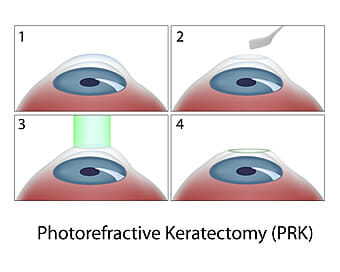 PRK (photorefractive keratectomy) is a refractive eye surgery technique similar to LASIK surgery as both use the excimer laser to reshape the cornea (the front surface of the eye), in order to change its ability to focus light on the retina. PRK is used to correct mild to moderate nearsightedness, farsightedness, and/or astigmatism. PRK can be the procedure of choice for patients whose cornea is too thin. PRK is a procedure that is an alternative to SMILE® and LASIK, though it offers the same great vision correction. It offers the same vision correction as LASIK but differs in the way the surface of the cornea is prepared. Schedule a free consultation with our doctors in Coushatta, LA to find our if it’s right for you!
PRK (photorefractive keratectomy) is a refractive eye surgery technique similar to LASIK surgery as both use the excimer laser to reshape the cornea (the front surface of the eye), in order to change its ability to focus light on the retina. PRK is used to correct mild to moderate nearsightedness, farsightedness, and/or astigmatism. PRK can be the procedure of choice for patients whose cornea is too thin. PRK is a procedure that is an alternative to SMILE® and LASIK, though it offers the same great vision correction. It offers the same vision correction as LASIK but differs in the way the surface of the cornea is prepared. Schedule a free consultation with our doctors in Coushatta, LA to find our if it’s right for you!
How Is PRK Different From LASIK?
PRK laser surgery differs from LASIK in that a corneal flap is not created before the laser is used to ablate the eye. During PRK, the outermost layer of the cornea, the epithelium, is completely removed. After the epithelial layer is removed, the surgeon uses a laser to reshape the cornea. In LASIK surgery, a corneal flap is created with a microkeratome blade or a laser, allowing the surgeon to access and reshape underlying layers of corneal tissue.
The primary difference between PRK and LASIK is that with PRK the excimer laser carefully sculpts the outer layer of the cornea to create an optimal surface for the eye’s lens. Conversely, LASIK surgery involves the creation of a corneal flap using either a microkeratome blade or a femtosecond laser prior to using the excimer laser to correct the inner surface of the eye.
Why Should I Get PRK Instead Of LASIK?
Those who have been told that their corneas are too thin for LASIK and those who have concerns about the creation of a corneal flap may consider PRK as an option for vision correction. Results are generally the same between PRK and LASIK, but the healing and recovery time is significantly longer with PRK.
What Is The Procedure For PRK?
When PRK is performed, the outer covering of the eye is removed, and the EX500 Excimer Laser is used to reshape the cornea.
Once the laser has been completed, a bandage contact lens is placed protecting the eye. Over the next 4-7 days, the soft outer covering begins to grow back and heal. During your recovery, you can see, and function normally.
What Is The Recovery Process For PRK?
Discomfort after PRK may be more severe and last longer (up to two weeks) than the discomfort associated with LASIK. However, the corneal flap created during the LASIK procedure may take years to heal and those with strenuous jobs and/or recreational activities may opt to have PRK rather than LASIK to avoid the risk of damaging the corneal flap. PRK is thought to leave the cornea stronger after surgery in comparison to LASIK.


